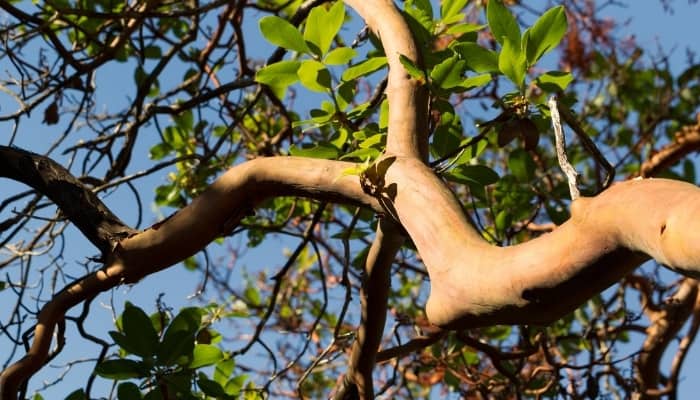Have you ever encountered trees with thin, smooth bark that looks similar to layers of onion? It may surprise you to learn that some of the roughest, most gnarled tree textures started out with a smooth surface.
Here are 12 kinds of smooth bark trees and how to spot them…
1. Birch
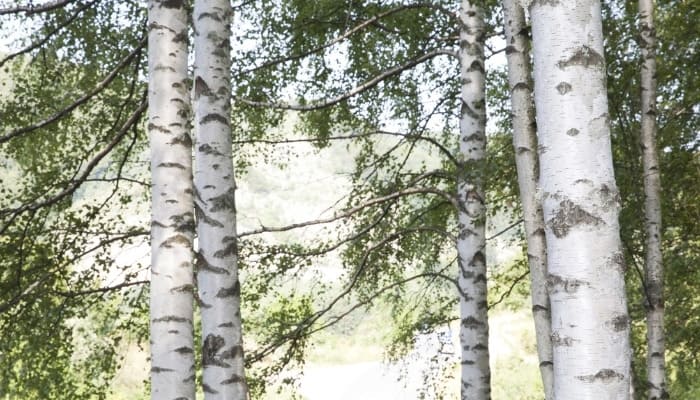
Birch trees are deciduous and found in woodlands, along riverbanks, and on mountainsides in USDA Hardiness Zones 2-6 (or 7 in harsher winter climates).
How To Identify
- Bark has a papery texture with dark horizontal streaks known as lenticels scored on the surface. The bark is often reddish before turning grayish-white/silver and peels in narrow strips, exposing pink, orange, or rust-brown bark beneath.
- Birches have a slim, conical habit with arching branches.
- Leaves are 2-3 inches long and can be ovular, triangular, or diamond shaped with serrated edges.
- Foliage turns from medium green to warm yellow, bronze, orange, and red tones in the fall.
- Birches grow 40-70 feet high and bloom early-late spring, producing drooping bronze/purple flowering spikes
2. Aspen
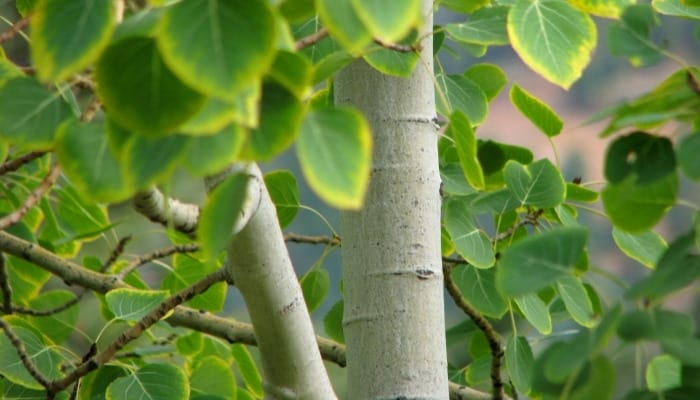
These deciduous trees thrive in Grow Zones 1-7 and are found in sandy woodlands, savannahs, marshes, and near lakes.
How To Identify
- Bark is pale to greenish-gray and mostly smooth, though some varieties are indented with diamond-shaped lenticels that merge into vertical grooves with age.
- Aspens have a slender, airy shape with top branches that bend horizontally in maturity – a sight that’s particularly distinctive in winter.
- Leaves begin triangular in shape before becoming more rounded with softly serrated edges. They measure 0.9-2 inches long.
- Aspen foliage turns from deep green to vivid yellow/red shades in fall.
- These reach 20-80 feet high and bloom around February-April, producing furry caterpillar-like flowering spikes that are reddish-pink (on male aspens) or grayish-green (female).
3. Beech
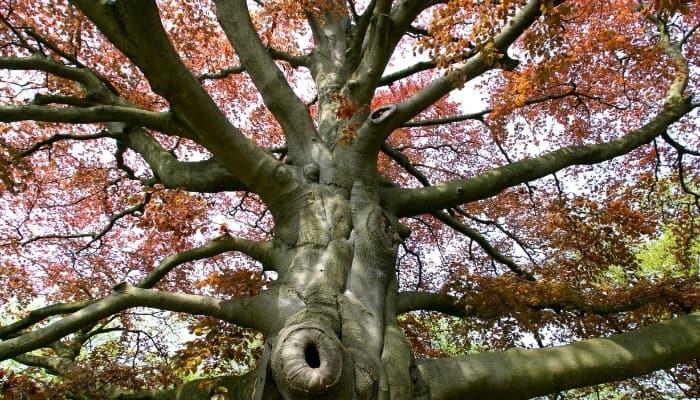
Deciduous beech trees are found in wet woodlands, wooded slopes, and shady riverbanks in Zones 3-9.
How To Identify
- Bark is smooth and silvery-gray in youth before developing knots and bumps with age as well as shallow ridges that form horizontally along the length of the trunk.
- Trees have a pyramid to rounded crown habit with a tall single trunk, though some species have several large trunks with branches low to the ground.
- The 6-inch-long leaves are elliptical with pointed tips and have well-defined parallel veins. Foliage morphs from dark green to yellow/orange/copper tones in the fall.
- Winter exposes its distinctive zig-zagging branch habit, and many dead bronzed leaves remain throughout winter.
- Beeches grow around 60-80 feet high and produce drooping clusters of yellowish-green tassel-like blooms in mid-late spring.
4. Paperbark Maple
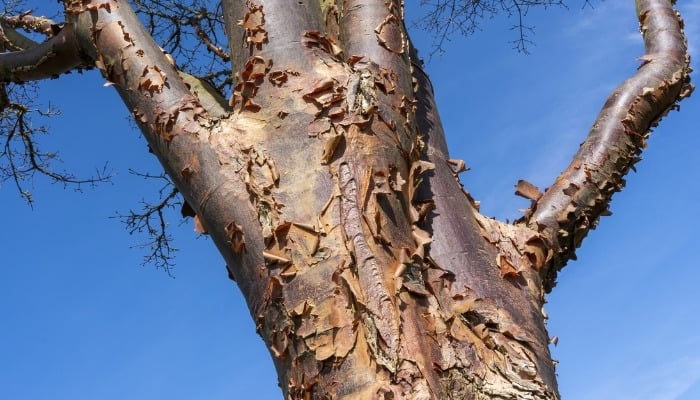
These small, slow-growing deciduous trees prosper in Zones 4-8 and are typically found in moist, sheltered locations.
How To Identify
- Its smooth vivid bark can be chestnut-brown, cinnamon, or orange depending on the variety. It peels in delicate papery curls, exposing a rose or tan-colored bark layer beneath.
- Trees have a rounded, fan-like habit with slender upward-growing branches.
- The dark-green three-lobed leaves are 3-6 inches long with blunt toothed edges and have bluish-green/gray-green undersides.
- In fall, the foliage turns vibrant shades of red, orange, and reddish green.
- Paperbark maples grow 20-30 feet high and produce non-showy pendulous yellow blooms between April-May.
5. Japanese Stewartia
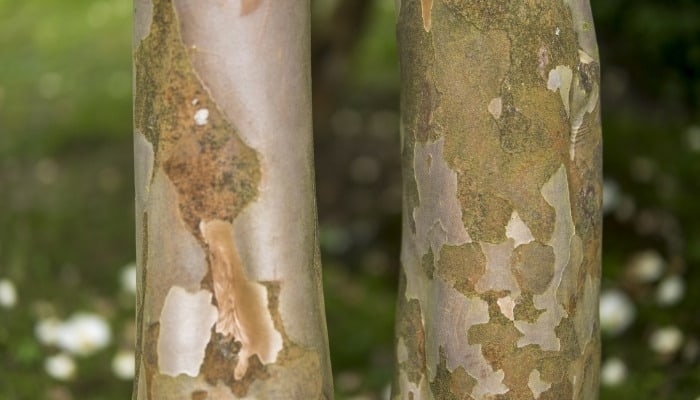
Japanese Stewartias are small deciduous trees growing in Zones 5-8 and are found in moist woodlands and shaded mountain regions.
How To Identify
- Bark begins pale gray, but as its foliage sheds in fall, the bark exfoliates in a stunning patchwork of charcoal-gray, reddish-brown, and orange shapes.
- Trees have an airy and graceful pyramid habit with semi-weeping branches.
- Leaves are matte dark green with an ovular shape and pointed tips, measuring 2 inches long.
- In the fall, the foliage puts on a vivid display of orange/red/burgundy hues.
- Japanese Stewartias grow between 12-40 feet high and produce dainty cup-shaped flowers in early summer of five white petals with coiled yellow anthers.
6. Japanese Clethra
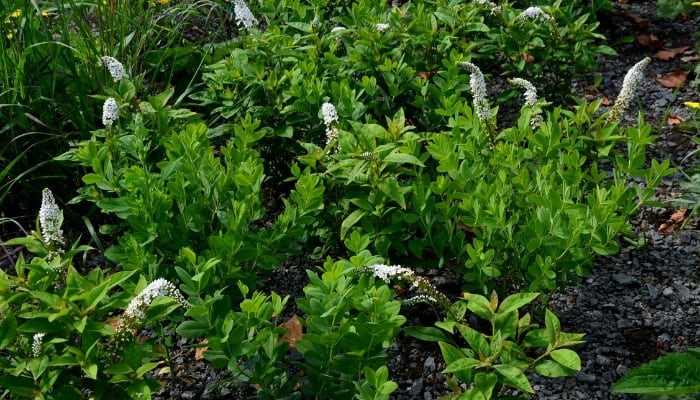
Japanese Clethras are small deciduous trees that grow best in Zones 5-8 and can be found in wooded hills, sunny mountain forests, and high-altitude stony habitats.
How To Identify
- Its shiny bark can be grayish-brown or cinnamon. It exfoliates in strips during winter, exposing beautiful mottled patches of pale salmon, lavender, cream, and gray.
- Trees have a bushy and oval to softly triangular habit with upright, spreading branches.
- Its ovular leaves are glossy and grayish-dark green with finely toothed edges, growing 2-6 inches long.
- The foliage takes on warm tones of bright/golden yellow/red in the fall.
- Japanese Clethra typically grows between 9-20 feet tall, and around mid-late summer, these bloom with long white and fragrant flower clusters in a horizontal, spraying habit
7. Hornbeam
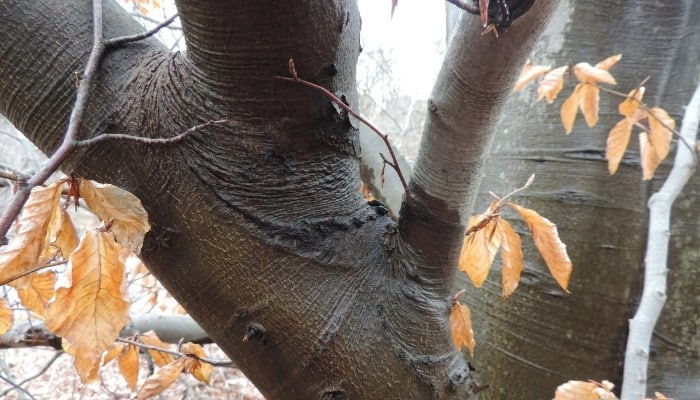
Compact hornbeams are deciduous shade trees normally found growing as understory trees in forest and woodland areas. They prosper in Zones 3-9.
How To Identify
- Hornbeam bark begins grayish brown and smooth in youth before becoming bluish gray and developing vertical deep furrows and flared ridges.
- Trees have dense oval-shaped canopies with a short trunk that twists and forms slightly crooked branches.
- Its ovular leaves measure 2-4 inches long and have deeply ridged veins and densely serrated edges.
- By fall, its dark-green leaves turn golden yellow/red/deep orange.
- Hornbeam trees reach 20-30 feet tall and produce pendulous flower spike clusters in green/reddish brown around April.
8. Mexican Sycamore
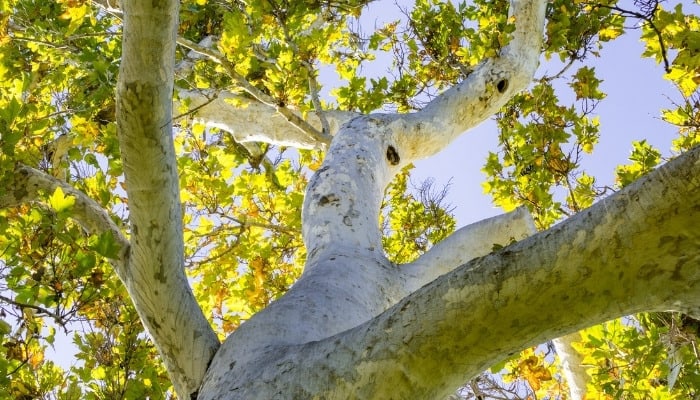
Mexican sycamores are large deciduous trees found growing in tropical forest habitats and along streams. They tend to thrive in Zones 7-10.
How To Identify
- Bark is light brown to chalky white, and once mature, it peels away in patchwork strips to reveal a light-cream layer beneath.
- Trees have a rounded, bushy habit, growing from stout trunk bases that are around 2 meters in diameter. At maturity, these sycamores grow to a width of 30 feet.
- Its 8-inch wide leaves are olive green with downy, silvery undersides and are similar in shape to the classic Canadian maple leaf.
- In fall, the foliage takes on a rich, golden yellow color.
- These trees tend to reach about 40-80 feet tall and produce flowers from December-February that appear as bristly green balls dangling from the branches.
9. Smooth Bark Eucalyptus
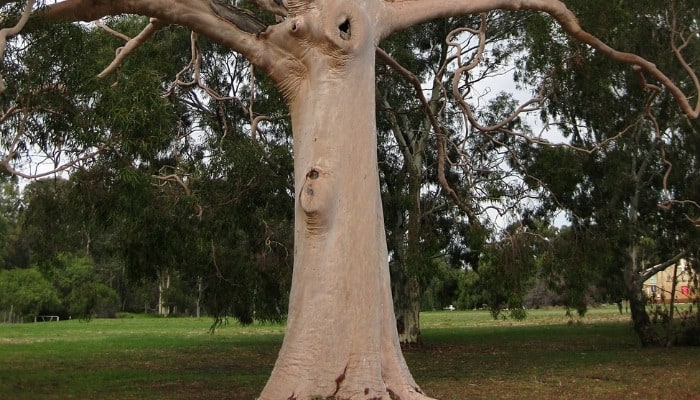
These evergreen trees grow best in Zones 7-11 and are naturally found in coastal and high-altitude areas of Western Australia.
How To Identify
- Bark is typically light gray/white and peels off in long ribbon-like curls each year as it reaches maturity, revealing orange, tan-colored or snowy-white layers.
- Trees can be tall, single-trunk structures with steep branches and dense crown canopy or multi-stemmed from ground level with branchlets, creating an airy shape.
- The leaves are broad and lance shaped in youth before becoming more narrow.
- Over fall/winter, the leaves remain but turn copper/purple/burgundy depending on the variety.
- These can grow between 9-49 feet high and produce flower buds in clusters of seven that bloom into white cup-shaped flowers between February and June.
10. Desert Ironwood
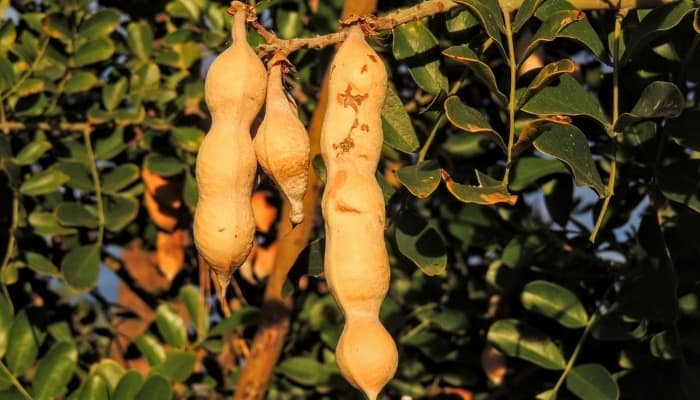
These drought-tolerant deciduous trees are typically found in southwestern desert areas and fare best in Zones 9-11.
How To Identify
- The bark is smooth and iron-gray, but with age, it develops horizontal fissures from which multiple sharp horns begin to sprout.
- Trees have a multi-trunk habit with strong, wide-spreading branches, creating a 30-foot-wide canopy that almost touches the ground.
- Foliage consists of 2-4 “fingers” that each holds multiple pairs of small rounded leaves (each measuring 0.7-2.5 centimeters across).
- The gray-green leaves feature tiny sharp hairs on their undersides and drop during dry periods over winter.
- These reach 20-50 feet high and produce purple/pale-pink flower clusters between April and May.
11. Ash
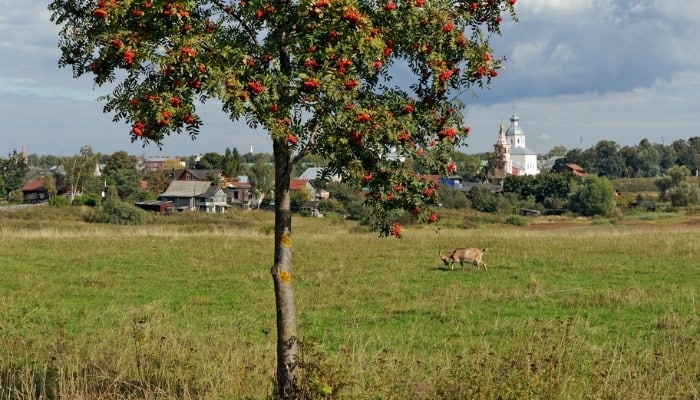
Ash trees are deciduous and thrive in Zones 3-9. They’re typically found in woodlands and at the ridges of major streams.
How To Identify
- Bark begins life smooth and pale gray, but with age, deep fissures and ridges appear vertically along the tree in addition to knots and lumps, and the bark turns grayish-brown.
- Trees develop a large oval habit from a 1-meter-wide trunk, and their branches and shoots have a deeply curved, upward growth.
- Its deep-green leaves can be lance shaped or more ovular with toothed edges and measure 8-12 inches long.
- Foliage briefly changes to a golden-yellow hue in fall.
- Ash trees grow around 30-50 feet high and put out clusters of feathery white/purple flowers around April/May, (but won’t bloom until they’re around 30 years old).
12. Red Maple
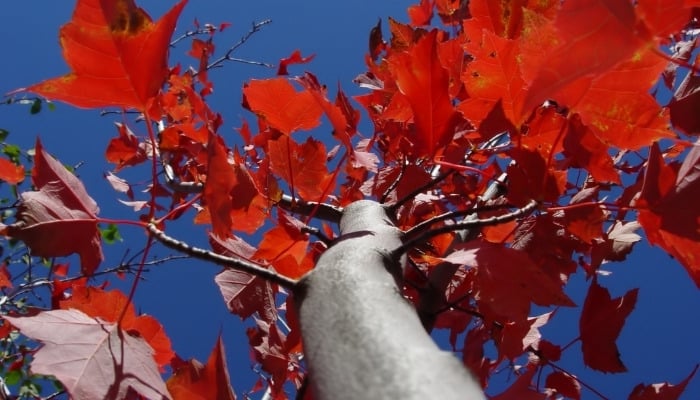
Deciduous red maples fare best in Zones 3-9 and are normally found along dry ridges, peat bogs, and swampland.
How To Identify
- Bark begins smooth and pale gray before developing rough vertical ridges with age, gradually peeling off in rough flakes.
- Trees have an upright pyramid-like habit before growing into a more rounded canopy in maturity. The twigs start out glossy and green before appearing reddish in the fall.
- Leaves are 2-5 inches wide with five lobes in the classic maple leaf shape and begin light green before turning a dazzling bright red/burgundy/orange/yellow during fall.
- Red maples normally reach between 60-90 feet high and send out dense clusters of reddish-golden flowers around early-mid March.
Conclusion
Who knew smooth bark trees varied so much?! Some possess bark so thin and delicate that it peels right off, as in the case of birch and paperbark maples.
Others get a little rougher around the edges as they age, developing ridges, bumps, and grooves like beech, ash, and red maple.

